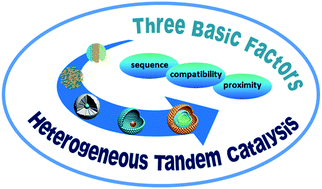Core–shell nano/microstructures for heterogeneous tandem catalysis
Abstract
Tandem catalysis, featuring the transformation of reactants into target products through two or more steps of catalytic reactions in one single reactor, has become a growing research field, due to its advantages of economic benefit and environmental protection. Heterogeneous tandem catalysts have an advantage in industry owing to their easier separation from the catalytic system. We summarize three factors in designing an excellent heterogeneous tandem catalyst, including sequencing, proximity and compatibility of different catalytic sites. The above three factors can be satisfied by changing the packing style or designing the nano/micro structure of the heterogeneous tandem catalysts. It is worth noting that due to the unique structural features and physicochemical properties, advanced nano/microstructure materials can display some functions that cannot be obtained by a simple nanoparticle, especially in heterogeneous tandem catalytic reactions. In this review, firstly, the traditional heterogeneous tandem catalysts are introduced and further divided into multi-bed catalysts and randomly mixed catalysts, according to the packing style of the catalysts or catalytic sites. Secondly, we draw forth the characteristics of the nano/microstructure design of the tandem catalyst, and combine specific examples to illustrate its structural advantages. In this part, core–shell structures, including solid core–shell structures and heterogeneous hollow structures (yolk–shell structures and interlayer-hetero hollow multi-shelled structures (HoMSs)), are considered as ideal candidates for heterogeneous tandem catalysts owing to their excellent capacity to balance the aforementioned three factors. Meanwhile, the main preparation methods of interlayer-hetero HoMSs are also summarized. By summarizing the requirement of multistep catalysis, we conclude the new concept of the temporal-spatial order property for tandem catalysts as a perspective at the end of this review. This paper is helpful to get better insight into the design and application of well-defined heterogeneous tandem catalysts for both the energy and environmental fields.

- This article is part of the themed collections: 2021 Materials Chemistry Frontiers Review-type Articles and Hollow Structures for Energy Applications


 Please wait while we load your content...
Please wait while we load your content...